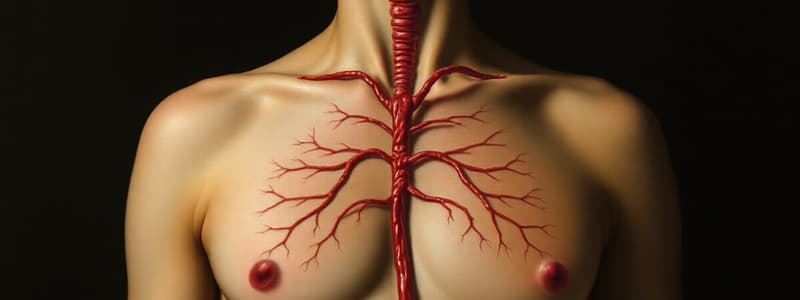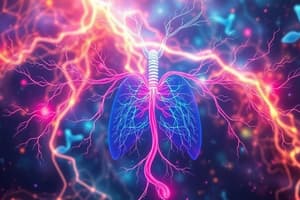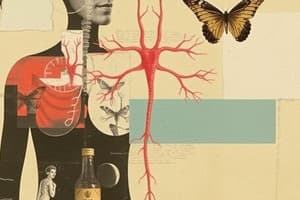Podcast
Questions and Answers
Which hormone is primarily secreted by the zona glomerulosa of the adrenal cortex?
Which hormone is primarily secreted by the zona glomerulosa of the adrenal cortex?
- Cortisol
- Aldosterone (correct)
- Epinephrine
- Norepinephrine
What is the primary function of cortisol secreted by the zona fasciculata?
What is the primary function of cortisol secreted by the zona fasciculata?
- Increasing renal filtration
- Stimulating hormone production in other glands
- Regulating metabolic rate
- Immune suppression (correct)
Which of the following hormones is NOT secreted by the adrenal medulla?
Which of the following hormones is NOT secreted by the adrenal medulla?
- Cortisol (correct)
- Norepinephrine
- Androgens
- Epinephrine
Which zone of the adrenal cortex is responsible for the production of androgens?
Which zone of the adrenal cortex is responsible for the production of androgens?
What triggers the secretion of aldosterone from the adrenal glands?
What triggers the secretion of aldosterone from the adrenal glands?
Which hormones are primarily produced in the adrenal medulla?
Which hormones are primarily produced in the adrenal medulla?
What role does glucagon play in glucose metabolism?
What role does glucagon play in glucose metabolism?
Which organ primarily utilizes glucagon to regulate blood sugar levels?
Which organ primarily utilizes glucagon to regulate blood sugar levels?
What is the result of glucagon action on glycogen in the liver?
What is the result of glucagon action on glycogen in the liver?
Which of the following accurately describes the relationship between glucose and glycogen?
Which of the following accurately describes the relationship between glucose and glycogen?
What happens to glycemic levels when glucagon is released?
What happens to glycemic levels when glucagon is released?
What is the primary effect of glucagon on glycogen reserves?
What is the primary effect of glucagon on glycogen reserves?
Which process is primarily stimulated by glucagon in relation to glucose?
Which process is primarily stimulated by glucagon in relation to glucose?
Which hormone signaling mechanism involves the regulation of hormone release through feedback loops?
Which hormone signaling mechanism involves the regulation of hormone release through feedback loops?
Which of the following glands is primarily responsible for regulating the body's metabolism?
Which of the following glands is primarily responsible for regulating the body's metabolism?
What main function does the hypothalamus serve within the endocrine system?
What main function does the hypothalamus serve within the endocrine system?
The adrenal glands are primarily associated with which body response?
The adrenal glands are primarily associated with which body response?
Which of the following is NOT a major function regulated by the endocrine system?
Which of the following is NOT a major function regulated by the endocrine system?
Which gland is involved in blood sugar regulation?
Which gland is involved in blood sugar regulation?
Which aspect of the endocrine system is primarily associated with the hypothalamic-pituitary-adrenal (HPA) axis?
Which aspect of the endocrine system is primarily associated with the hypothalamic-pituitary-adrenal (HPA) axis?
What role do gonads play in the endocrine system?
What role do gonads play in the endocrine system?
What is the primary function of the parathyroid glands?
What is the primary function of the parathyroid glands?
Which structure is involved in the respiratory system as outlined in the content?
Which structure is involved in the respiratory system as outlined in the content?
Identify the cells within the parathyroid glands that are specifically mentioned in the content.
Identify the cells within the parathyroid glands that are specifically mentioned in the content.
Where is the esophagus located in relation to the pharynx?
Where is the esophagus located in relation to the pharynx?
Which gland is associated with metabolic regulation through hormone production?
Which gland is associated with metabolic regulation through hormone production?
What is the main distinction between parathyroid cells and oxyphil cells?
What is the main distinction between parathyroid cells and oxyphil cells?
Which component is part of the upper digestive tract?
Which component is part of the upper digestive tract?
What regulatory function is associated with the capillary network in the endocrine system?
What regulatory function is associated with the capillary network in the endocrine system?
Which is the correct relationship between the thyroid gland and parathyroid glands?
Which is the correct relationship between the thyroid gland and parathyroid glands?
Which structure serves as a conduit for both air and food?
Which structure serves as a conduit for both air and food?
Flashcards
Glucose
Glucose
A simple sugar that is the body's primary source of energy.
Glycogen
Glycogen
A complex carbohydrate stored in the liver and muscles, serving as a reserve of energy.
Liver
Liver
A large organ involved in various functions, including glucose storage and release.
Glucagon
Glucagon
Signup and view all the flashcards
Glycogen breakdown
Glycogen breakdown
Signup and view all the flashcards
Pancreas
Pancreas
Signup and view all the flashcards
Insulin
Insulin
Signup and view all the flashcards
Zona glomerulosa
Zona glomerulosa
Signup and view all the flashcards
Zona fasciculata
Zona fasciculata
Signup and view all the flashcards
Zona reticularis
Zona reticularis
Signup and view all the flashcards
Adrenal medulla
Adrenal medulla
Signup and view all the flashcards
Aldosterone
Aldosterone
Signup and view all the flashcards
Cortisol
Cortisol
Signup and view all the flashcards
Endocrine System
Endocrine System
Signup and view all the flashcards
Hormones
Hormones
Signup and view all the flashcards
Endocrinology
Endocrinology
Signup and view all the flashcards
Hypothalamus
Hypothalamus
Signup and view all the flashcards
Pituitary Gland
Pituitary Gland
Signup and view all the flashcards
HPA Axis
HPA Axis
Signup and view all the flashcards
Thyroid Gland
Thyroid Gland
Signup and view all the flashcards
Parathyroid Glands
Parathyroid Glands
Signup and view all the flashcards
Esophagus
Esophagus
Signup and view all the flashcards
Parathyroid cells
Parathyroid cells
Signup and view all the flashcards
Trachea
Trachea
Signup and view all the flashcards
Capillaries
Capillaries
Signup and view all the flashcards
Oxyphil cells
Oxyphil cells
Signup and view all the flashcards
Pharynx
Pharynx
Signup and view all the flashcards
Larynx
Larynx
Signup and view all the flashcards
Esophageal muscles
Esophageal muscles
Signup and view all the flashcards
Study Notes
Endocrine System Overview
- The endocrine system regulates homeostasis over long periods (hours, days, weeks)
- Hormones are chemicals released into the bloodstream to regulate distant cells
- Endocrinology is the study of hormones and endocrine organs
Major Endocrine Processes
- Reproduction
- Growth and development
- Electrolyte, water, and nutrient balance in the blood
- Cellular metabolism and energy balance
- Immune defenses
Major Endocrine Glands
- Hypothalamus
- Pituitary gland (anterior and posterior)
- Thyroid gland
- Parathyroid glands
- Adrenal glands
- Pineal gland
- Pancreas (endocrine portion)
- Gonads (ovaries and testes)
Hypothalamus-Pituitary Axis
- The hypothalamus is the control center for the endocrine system
- It releases or inhibits hormones that affect the anterior pituitary
- The anterior pituitary releases tropic hormones that act on other endocrine glands
- Peripheral endocrine glands release hormones that affect target cells and body functions
- Target cells have receptors for particular hormones, causing changes in homeostasis
Hypothalamus-Anterior Pituitary Hormones
- 7 hormones are released by hypothalamus to regulate anterior pituitary
- Examples include TRH (thyrotropin-releasing hormone), CRH (corticotropin-releasing hormone), GnRH (gonadotropin-releasing hormone)
Hormones and Their Glands
- Hypothalamus: ADH, oxytocin, releasing/inhibiting hormones (GHRH, GHIH, TRH, CRH, GnRH, PIH)
- Anterior Pituitary: growth hormone, TSH, ACTH, FSH, LH, PRL
- Thyroid Gland: thyroid hormone, calcitonin
- Parathyroid Gland: parathyroid hormone
- Adrenal Cortex: aldosterone, cortisol, DHEA, androgens
- Adrenal Medulla: epinephrine, norepinephrine
- Pineal Gland: melatonin
- Pancreas: insulin, glucagon
- Gonads: estrogen, progesterone, testosterone (more detail in reproductive chapter)
Growth Hormone
- Growth hormone (somatotropin) is an amino acid-based hormone produced by the anterior pituitary.
- Functions: metabolism (throughout life), fat breakdown, increased blood glucose, protein synthesis (muscle mass, cellular growth), bone growth, and increased cell division.
- Regulation: hormonal (GHRH, GHIH from hypothalamus; negative feedback of IGF-I and GH); neural (diurnal rhythms, increase with sleep)
Growth Hormone & IGF's
- Growth hormone actions are mediated by insulin-like growth factors (IGFs), also called somatomedins
- IGF-I is mainly released into blood by the liver, and produced by individual tissues, stimulating soft tissue and bone growth
- IGF-II is primarily involved in fetal development
Growth Hormone Pathway
- Growth hormone (GH) is made and released by the anterior pituitary in response to growth hormone releasing hormone (GHRH) from the hypothalamus
- Target cells include the liver, adipose tissue, and all body cells
- Regulation includes negative feedback from IGFs and GH to the anterior pituitary, and GHIH (somatostatin) from the hypothalamus
Growth Hormone Syndromes
- Hypersecretion: gigantism (whole body enlarged) or acromegaly (enlarged extremities)
- Hyposecretion: dwarfism
- Treatment for dwarfism is effective if diagnosed before epiphyseal plate closure. Other issues include abuse of GH by bodybuilders, athletes, and elderly.
Thyroid Hormone
- Thyroid hormones (T3 and T4) are lipid-soluble, major metabolic hormones
- T4 (tetraiodothyronine) is the stored and secreted form
- T3 (triiodothyronine) is more potent and biologically active
- Produced and released by the thyroid gland; bow-tie shaped organ below larynx
- Function: increased metabolic rate, heat production, growth, CNS development, SNS activity
- Regulation: hormonal (TRH, TSH), neural (body temperature, stress)
Thyroid Hormone Pathway
- Stimulus: TRH (hypothalamus), TSH (anterior pituitary)
- Production & Release: thyroid gland
- Target cells: body cells (metabolism & heat production, tissue growth & development, blood vessel SNS receptors to maintain blood pressure)
- Regulation: negative feedback to hypothalamus and the anterior pituitary from T3 & T4; hormonal inhibition (GHIH, dopamine, glucocorticoids), neural (cold in infants, stress)
Thyroid Hormone Synthesis
- Thyroid hormones are made from amino acid tyrosine and iodine.
- Steps involve: thyroglobulin synthesis, iodide transport into follicle cells, converting iodide to iodine, attaching iodine to tyrosine in the colloid, forming T3 and T4, taking T3- and T4-thyroglobulins back into follicle cells, and cleaving T3 and T4 from thyroglobulins, allowing them to diffuse into the blood
T4 to T3 conversion
- T4 is the major form of thyroid hormone stored and secreted by the thyroid
- T3 is 80% made from T4 by removing iodine from the liver or kidneys; 20% is secreted as T3 by the thyroid gland
- T3 is 10 times more potent and biologically active
Thyroid Hormone Syndromes
- Hyperthyroidism: excess T3 and T4 (Graves' disease, tumors; symptoms: high metabolism, sweating, tachycardia, bulging eyes)
- Hypothyroidism: low T3 and T4 (lack of iodine, deficiency, or disease; symptoms: low metabolism, cold, sluggish, dry skin, edema, myxedema, cretinism, goiter)
Calcitonin
- Produced by parafollicular cells of the thyroid.
- Reduces blood calcium levels, inhibits bone breakdown, and stimulates calcium storage in bones.
- Regulation: blood calcium (humoral); not crucial in humans
Parathyroid Hormone
- Produced by the parathyroid glands (tiny glands on the thyroid's posterior side)
- Increases blood calcium (amino acid based)
- Function: Increases plasma Ca++, decreases plasma PO4--, stimulates vitamin D.
- Blood (humoral) regulation: related to blood Ca2+ levels
- Requires calcium homeostasis; removal can be fatal
Parathyroid Hormone Pathway
- Stimulus: low blood calcium
- Target organ: bone (increase in Ca2+ release, increase in bone breakdown, Ca2+ and PO4 release via stimulation of osteoclasts) and kidneys (increase in blood calcium retention, decrease in blood phosphate, vitamin D activation by kidneys. and small intestine vitamin D needed for calcium absorption in diet), blood (humoral): High Ca2+ in blood directly inhibits parathyroid hormone production and release.
Parathyroid Hormone Syndromes
- Hyperparathyroidism is usually caused by tumors and results in bone loss and nervous system issues.
- Hypoparathyroidism can be caused by removal (thyroid surgery) or magnesium deficiency and the resulting issue includes muscle spasm, nervousness, and other issues
Adrenal Glands
- Small, capped glands above the kidneys
- Adrenal Cortex (outer region): steroid hormones (mineralocorticoids, glucocorticoids, sex hormones)
- Adrenal Medulla (middle region): catecholamines (epinephrine, norepinephrine)
Adrenal Medulla
- Catecholamines (epinephrine, norepinephrine) produced and released by the adrenal medulla
- Target cells: SNS organ targets
- Function: Enhance sympathetic effects, stress response, and blood pressure regulation.
- Regulation: the sympathetic nervous system
Adrenal Cortex
- Steroid hormones, specifically mineralocorticoids (aldosterone, fluid balance: increases Na+ in blood, decreases K+ in blood), glucocorticoids (cortisol, metabolism: increase blood glucose, increase protein breakdown, increase fat breakdown, immune response block pathways & antibody production), and sex hormones (androgens) produced and released by the adrenal cortex NOTE: Aldosterone deficiency is FATAL; regulated by the renin-angiotensin system and the kidneys
Mineralocorticoids (Aldosterone)
- Primarily aldosterone; regulates fluid balance; increases Na+ retention, decreases K+ excretion
- Deficiency is fatal
- More details in Chapter on Renin-Angiotensin System and kidneys
Gonadocorticoids (Sex Hormones)
- Includes androgens such as DHEA, androstenedione, testosterone, the weak precursors of testosterone in females during puberty, and estrogen
- Adrenal cortex produces DHEA
- Ovaries and testes produce estrogen and testosterone
Glucocorticoids (Cortisol)
- Primarily cortisol; regulates metabolism
- Increase blood glucose levels; sequester glucose to the brain, increase protein breakdown, and increased fat breakdown
- Associated with stress response, suppresses the immune system, blocks inflammatory pathways and antibody production
Cortisol Pathway
- Stimulus: CRH (hypothalamus), ACTH (anterior pituitary)
- Targets: all body cells
- Functions: gluconeogenesis, immune system suppression, breakdown of fats, and proteins
- Regulation: Neural (stress), hormonal (negative feedback from high cortisol to CRH and ACTH)
Cortisol Syndromes
- Hyposecretion: Addison's disease (weight loss, low blood glucose, low blood ions, dehydration, and hypotension)
- Hypersecretion: Cushing's syndrome (“moon face”, increased abdominal/back fat, muscle/bone weakness)
Insulin
- Lowers blood glucose; amino acid based
- Produced and released by the pancreas.
- Functions: glucose uptake in muscle and fat cells, glycogen storage, inhibits glucose production
- Regulation: hormonal (neural, blood (humoral), increased by glucose, epinephrine, thyroxine, glucocorticoids; decreased by somatostatin. PSNS- post-eating)
Glucagon
- Increases blood glucose; amino acid based
- Produced and released by the pancreas
- Functions: glucose synthesis, glucose release, glycogen breakdown
- Regulation: hormonal (low glucose), neural (stimulated by sympathetic nervous system), inhibited by insulin and somatostatin
- Glucagon opposes Insulin
Type I and Type II Diabetes Mellitus
- Type I: lack of insulin secretion from the pancreas; typically treated with injected insulin
- Type II: normal insulin secretion, but target cells don't respond; treated with diet, exercise, sometimes insulin
Studying That Suits You
Use AI to generate personalized quizzes and flashcards to suit your learning preferences.




